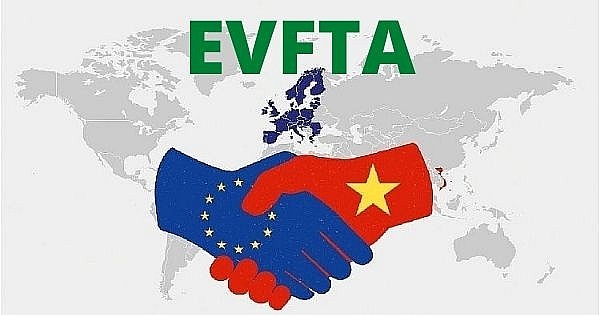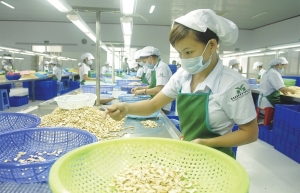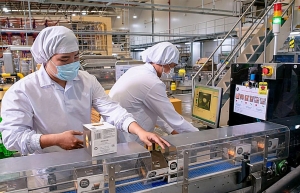Obstacles still to be ironed out to improve EVFTA’s standing
Julien Guerrier, head of the European delegation to Vietnam, told VIR last month that the EU-Vietnam Free Trade Agreement (EVFTA) had become important to lifting the commercial links between the two economies to an unprecedented height.
 |
| Obstacles still to be ironed out to improve EVFTA’s standing, illustration photo/ Source: Internet |
“We have witnessed the positive impact of the EVFTA on bilateral trade,” Guerrier said. “During 2020-2022, the annual growth in two-way trade was extremely high, at 13 per cent, even when considering the negative growth of minus 5 per cent in two-way trade in 2020. The enforcement of the EVFTA in 2020 has significantly cushioned the big negative drop of exports from both economies during the crisis and helped bring about the positive bounce back of their trade performance.”
According to Vietnam’s General Statistics Office, in 2023, bilateral trade hit $59.1 billion including $44.1 billion worth of Vietnam’s exports and $15 billion from the country’s imports, down 5.9 and 2.5 per cent, respectively.
Guerrier believes that some difficulties will reduce in scale.
“Based on this factual trade and investment development, we can predict a stable growing trend for the bilateral EU-Vietnam trade and investment flows in the coming years, even if we could witness a deceleration in growth or even some minor decreases after the miraculous expansion over the past few years,” he said.
Data from the Ministry of Planning and Investment indicates that the EU currently has a total stock of investment of approximately $28.3 billion, with about 2,450 projects.
Bernd Lange, chairman of the European Parliament’s Committee on International Trade, told VIR in late January during his visit to Vietnam to oversee implementation of the EVFTA that there had been “a big successful story in trade cooperation” between both sides, and as much as 71 per cent of tariff lines for Vietnamese exports to the EU have been removed so far, while 65 per cent of tariff lines for EU goods exported to Vietnam have followed suit.
“About 30 per cent of the trade balance has tilted towards Vietnam. This is excellent for the Vietnamese economy,” Lange said.
However, he added that to keep the trade balance in favour of both sides and for Vietnam to draw in more investment from the EU, much remains to be done.
“For example, the Vietnamese government would need to make it more favourable for licensing the circulation of pharmaceutical products in the domestic market. The EVFTA implementation would mean fair benefits for all people,” he said.
Under the EVFTA commitments, more than half of the tariffs on pharmaceutical imports from the EU have been removed, but the Ministry of Health has released a draft amendment to the Law on Pharmacy that would give foreign pharmaceutical companies more rights and incentives.
For example, the scope of activities eligible for pharmaceutical investment incentives has been expanded to include fields such as the manufacturing of new, generic speciality, and high-tech drugs; drugs created through tech transfer for production in Vietnam; essential drugs as well as those for the prevention and control of social diseases; and vaccines and biological products.
“In addition, we have told some Vietnamese leaders that procedures for importing a number of types of goods from the EU into Vietnam remain cumbersome,” Lange said.
“Many European investors are also waiting for Vietnam to improve the policy in renewable energy development. Currently, some German companies are ready to invest in some projects in the country but face hurdles about feed-in tariffs and power purchasing agreements.”
Though Vietnam has enacted the Power Development Plan VIII, which prioritise renewable energy development, the European Chamber of Commerce pointed out in its White Book released in January that there has been an unclear investor selection process.
“Currently, there is little visibility as to how investors will be selected for future energy projects,” the White Book stressed.
When it comes to offshore wind surveys and investor selection links, EuroCham said that there was a lack of pathways being approved to undertake offshore surveys, and then the benefits of securing and undertaking these with requirements from the implementation plan and investor selection process as to how projects will be selected and to who.
“What Vietnam has achieved so far is still below its potential and that potential cannot be optimised in the absence of vigorous reforms and a strong determination to simplify cumbersome administrative procedures and eliminate complicated licences and sublicences,” Guerrier said.
“The EU is closely observing Vietnam’s implementation of its FTA commitments, which should help resolve technical barriers in market access. We cannot wait to see stronger growth of trade and investment and turn the potential of our bilateral relations into reality.”
| EVFTA’s benefits for businesses The trade agreement benefits businesses by eliminating 99 per cent of all tariffs and partially removing the remaining 1 per cent through limited zero-duty quotas; reducing regulatory barriers and overlapping red tape; protecting intellectual property rights, including geographical indications awarded to special regional food and drink products; opening up services and public procurement markets; and ensuring the agreed rules can be enforced. Vietnam removed 65 per cent of its duties on EU goods the day the agreement entered into force. It will gradually remove the remainder by 2030. The EU will progressively remove its duties on imports from Vietnam by 2027. This asymmetric approach takes into account the fact that Vietnam is a developing country. The trade agreement removes tariffs on a range of key EU export products, including machinery, motorcycles, car parts, pharmaceuticals, textiles, and chemical exports. Specifically, - most machinery and appliances no longer have to pay Vietnamese import duties of up to 35 per cent – the rest will no longer do so by August 2025 - motorcycles with engines larger than 150cc will see Vietnamese import duties of 75 per cent gradually fully removed by August 2027 - most cars will see Vietnamese import duties of 78 per cent gradually removed by August 2030 - car parts will see Vietnamese import duties of up to 32 per cent gradually removed by August 2027 - about half of EU pharmaceuticals no longer have to pay Vietnamese import duties of up to 8 per cent – the rest will no longer do so by August 2027 EU textile exports no longer have to pay Vietnamese import duties of 12 per cent l nearly 70 per cent of EU chemicals exports no longer have to pay Vietnamese import duties of up to 5 per cent – the rest will be able to enter free of tariffs of up to 25 per cent after three, five or seven years. Besides eliminating tariffs, Vietnam has also agreed to remove its existing export duties on its exports to the EU, and not increase the few duties that will remain.Source: European Commission |
 | EU-Vietnam Free Trade Agreement implementation kicks into higher gear Vietnam and the EU are amplifying investment and trade ties seconded by a bilateral free trade deal, with the latter committing to assist the former in implementation. |
 | More leverage coming for EU trade deal success Vietnam and the EU are intensifying their cooperation in trade and investment. Julien Guerrier, Ambassador and head of the European Delegation to Vietnam, talked to VIR’s Thanh Tung about how the relations will develop in 2024 and beyond, with a major leverage of a bilateral trade deal. |
 | Scaling up new funding activities from Europe Vietnam has stood strong in a challenging global economy, showing impressive growth and attracting significant foreign direct investment in 2023. Despite global uncertainties, Vietnam saw a 62 per cent increase in foreign investment capital in 2023 and a 57 per cent rise in new projects, indicating its success in drawing in funding, particularly under the EU-Vietnam Free Trade Agreement (EVFTA) framework. |
What the stars mean:
★ Poor ★ ★ Promising ★★★ Good ★★★★ Very good ★★★★★ Exceptional
Related Contents
Latest News
More News
- KK Group opens global flagship store in Ho Chi Minh City (January 19, 2026 | 11:52)
- Gia Lai draws over $1bn in new investment so far this year (January 19, 2026 | 11:50)
- Unlocking capital flows for strategic and suitable projects (January 18, 2026 | 09:00)
- ACV begins cargo terminal construction at Danang Airport (January 17, 2026 | 15:57)
- Viettel starts construction of semiconductor chip production plant (January 16, 2026 | 21:30)
- Bel expands Vietnam production with $19.7 million investment (January 16, 2026 | 16:07)
- ASML signals long-term commitment to Vietnam (January 16, 2026 | 12:00)
- Ho Chi Minh City starts construction of four key infrastructure projects (January 15, 2026 | 17:22)
- PIDG invests with AquaOne to expand Xuan Mai’s treated water supply to Hanoi (January 15, 2026 | 11:16)
- Vietnam ranks 38th in global AI adoption (January 14, 2026 | 16:01)

 Tag:
Tag:




















 Mobile Version
Mobile Version